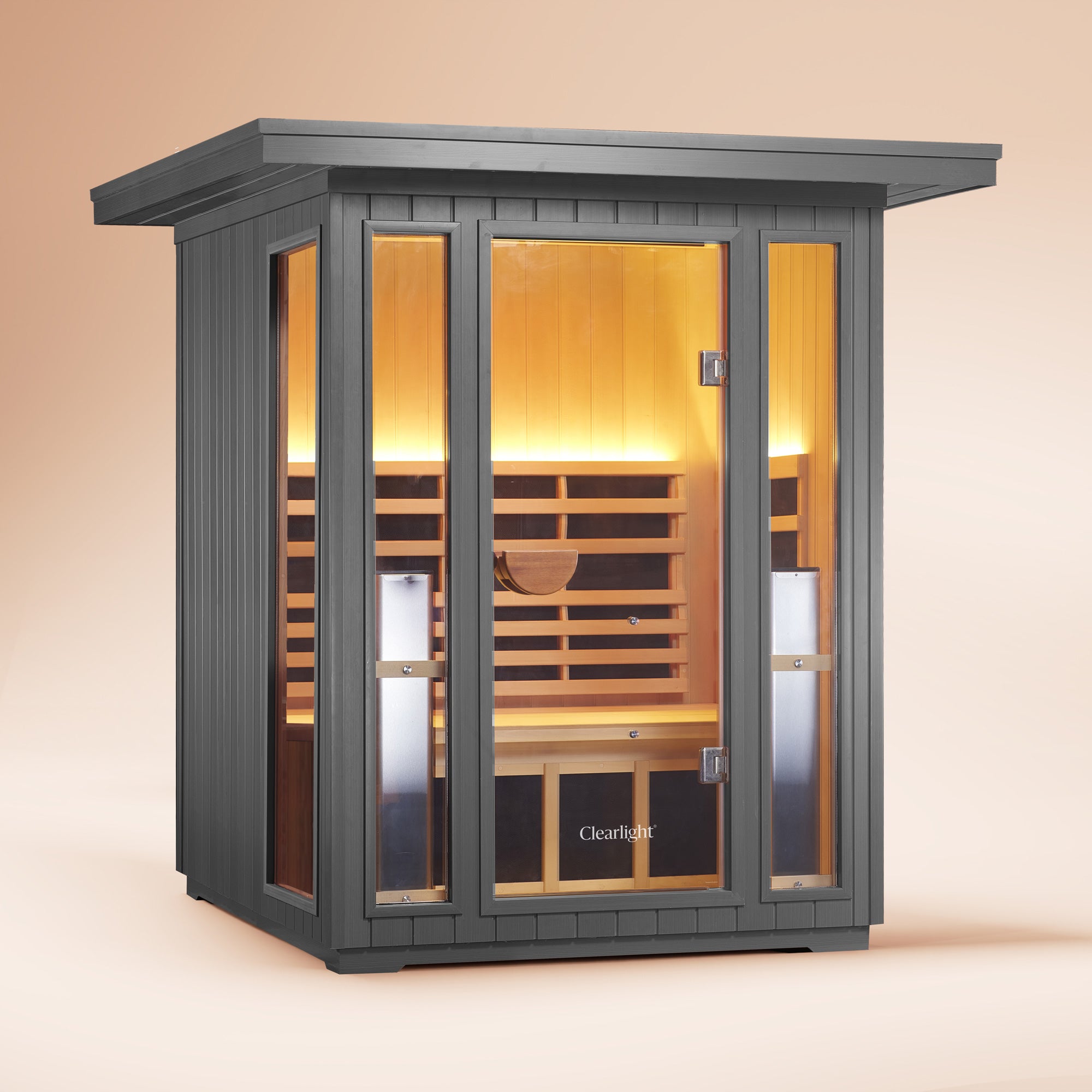Welcome to my blog post about the health benefits of saunas for joint pain. I’ll specifically look at how long you should use a sauna for pain. Different types of pain will be included, such as osteoarthritis, rheumatoid arthritis, and back pain.
I’ve written several blog posts about saunas and pain in the past, such as:
- Does Infrared Sauna Use Help With Arthritis And Chronic Pain?
- How To Use A Sauna For Sore Muscles
-
Using A Sauna For Back Pain: An Unexpected Match
Today I’ll also cover these topic in some detail but the most important topic I’ll consider is how long you should use a sauna for different types of pains, such as joint pain. If you’re short on time or just want to learn the essentials, I’ve added a summary below:
How Long To Use A Sauna For Rheumatoid Arthritis And Osteoarthritis
How long you should sauna for rheumatoid arthritis or osteoarthritis? Studies show that 15-30 minutes per day, 2-3 times per week offer great results for these purposes.
For other types of pain as well, such as fibromyalgia, 15-30 minutes per day twice per week is sufficient.
Other research that investigates the effects of saunas on inflammation shows the best results with four weekly sessions of 30 minutes or more. That inflammation is often not only intertwined with different types of pain, such as chronic lower back pain or osteoarthritis or rheumatoid arthritis, but also other health conditions. So you’ll want to avoid having chronically elevated inflammation levels.
Overall, therefore, for pain, I recommend four weekly sauna sessions of 30 minutes in an infrared sauna. And if you’ve got any chronic health conditions, consult with your physician first. Also, in that case, build up your exposure gradually as you might have decreased heat tolerance.
Over time, 30 minutes four times weekly yields superior results for different types of joint pain and chronic pain types. And to multiply the results you get, add a Red Light Therapy Tower to your sauna and use it while you’re using that sauna - it will multiply the pain-lowering and disability-inhibiting effects you’re getting.
Pain 101: Chronic Pain, Osteoarthritis, Rheumatoid Arthritis, Back Pain, And More
Chronic pain is a huge problem globally, affecting more people than heart disease, diabetes, and cancer combined (1; 2; 3; 4; 5). In the United Kingdom too, chronic pain is a big problem affecting millions (6; 7: 8; 9). Worldwide, more than an inconceivable 30% of people are affected by chronic pain. Chronic pain is defined as pain that’s present after three months even though the original cause of the pain has already healed.
Lower back pain and pain in the limbs are two of the most common chronic pain types. Chronic pain also tends to strongly affect quality of life because as the name already implies, the pain is present continually. Anxiety and depression is frequently present and the pain can even lead some to commit suicide as well, unfortunately.
Also, the more other health conditions you tend to have - such as heart disease or diabetes - the greater the likelihood that you’ll have chronic pain as well. The pain then generally tends to be worse as well.
Both osteoarthritis and rheumatoid arthritis are two common sources of chronic pain (10; 11; 12; 13; 14; 15). Both regular sensations and pain processes are often disrupted in people with these conditions. Up to 50% of people with rheumatoid arthritis have chronic pain, for instance, and 90% of people with the condition will visit a doctor for that reason. Osteoarthritis is now the leading cause for chronic pain in older adults.
The risk of both osteoarthritis and rheumatoid arthritis goes up as you age. Young people are rarely affected by them, as well as by chronic pain. Nevertheless, these types of pain are also the leading cause of disability in society. So, not only does the quality of life of many people go down because of (almost) continuous pain sensations, their ability to move or hold a job is also negatively impaired.
But arthritis is not the least of the problems. Lower back pain and neck pain are other health issues that affect people in their 20s and 30s. And, these lower back and neck pain problems cause lots of disability and absenteeism from work as well.
Pharmacological solutions may work though but almost never long-term. Side effects are the biggest long-term problem with these pharmaceuticals even though they’ll give wonderful short-term relief. Pharmaceuticals are promoted through marketing budgets that run into the billions and are sometimes addictive. Many people in the United Kingdom might also not have sufficient access to psychologists or physical therapists to really help them with their chronic pain.
Chronic pain or joint pain also cause a negative feedback loop frequently. For instance, with pain you’ll sleep more poorly. And with poor sleep, the pain will be worse, both physiologically and psychologically. So the more you can inhibit pain, the better life generally becomes for people with joint problems and/or chronic pain.
So that’s where saunas come in today. I’ll take you by the hand and lead you through the science on using a sauna for osteoarthritis, rheumatoid arthritis, back and neck pain, and so forth. I’ll not only focus on pain but also on how a sauna can increase your functionality despite the pain.
Merely reducing disability already confers a huge advantage upon you because you can more easily participate in society. So let’s being with the beginning:

Saunas For Different Types Of Joint Problems: Osteoarthritis, Rheumatoid Arthritis, Back And Neck Pain, And More
Below I’ll consider how long you should sauna for different types of joint pain conditions. I’ll also talk about what studies say about the ability of saunas to improve your functional capacity - such as your joint range of motion or the muscle strength around that joint.
Let’s go:
Saunas And Osteoarthritis 101. And How Long Should You Sauna For Osteoarthritis?
Osteoarthritis is a degenerative disorder of the joint (16; 17; 18). The cartilage of the bone is lost and disability is often the result. How debilitation the condition is varies widely though, as you can have joint problems without much pain or symptoms, or, alternatively, you might have lots of pain and loss of functionality with very little objective degeneration.
Fortunately, saunas can help with osteoarthritis (19; 20; 21). Infrared light is especially helpful here. The infrared light doesn’t just heat up your body. Instead, the infrared light (or heat) penetrates into your body and affects you at the cellular level.
People with osteoarthritis report lower overall pain levels in their daily lives when they integrate a sauna into their routine. That pain is subjectively measured with a “Visual Analogue Scale” (VAS). That VAS scale measures pain between 1 and 10, with 1 signifying “no pain” and 10 the “worst possible pain”.
People with osteoarthritis who use a sauna tend to have statistically significant lower VAS than those who don’t.
Overall, heat seems to help people with osteoarthritis well. Studies show that other “spa therapies”, such as hot showers, mud and mineral baths, and exercises in hot water tend to improve the condition.
For the best results for osteoarthritis, I recommend spending 30 minutes a day three times weekly in an infrared sauna. If you’ve got other health conditions, talk to your physician and work up to those 30 minutes slowly.
Next up:
Saunas And Rheumatoid Arthritis 101. And How Long Should You Sauna For Rheumatoid Arthritis
Rheumatoid arthritis isn’t just a joint condition but an autoimmune condition that influences the health of the joint (22; 23; 24; 25). Systemic inflammation plays a major role in rheumatoid arthritis. That inflammation, in turn, is intertwined with swelling, pain, and stiffness in the joints.
The condition normally starts with the smallest joints in the hands and feet and then progresses towards the bigger joints. If you don’t treat the condition, the entire joints can be damaged extremely badly. Disability is then the result. Fortunately, this is where infrared saunas come in.
Lots of studies exist on rheumatoid arthritis, saunas, and other forms of heat therapy (26; 27; 28; 29; 30; 31). Two infrared sauna sessions per week can already give massive results for people with rheumatoid arthritis. Over a period of eight treatments in the course of a month, stiffness and pain will be reduced significantly.
Also, no adverse effects occur after infrared sauna session treatments. Fatigue is also reduced. Overall, these results imply that there are huge reductions in overall disability when using an infrared sauna for rheumatoid arthritis. Why? Simple: if you can reduce both fatigue, pain, and stiffness, it means that you’re much more able to perform better in daily life.
Other studies confirm the reduction in pain in rheumatoid arthritis after sauna bathing. People with rheumatoid arthritis often start moving more, creating a positive feedback loop between more movement, less pain, which then results in more movement and less disability again.
You may ask: “So how long should I sauna for rheumatoid arthritis?” I believe the study setup I covered above is the minimum you should engage in, but three sessions per week often gives people of varying conditions (heart health, dementia, etc) better results. So I recommend two to three weekly sauna sessions using an infrared sauna specifically for rheumatoid arthritis, lasting 30 minutes per session.
Next up:












How Long Should You Sauna For Muscle Recovery?
How Infrared Saunas Improve A Natural Immunity